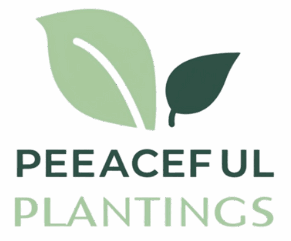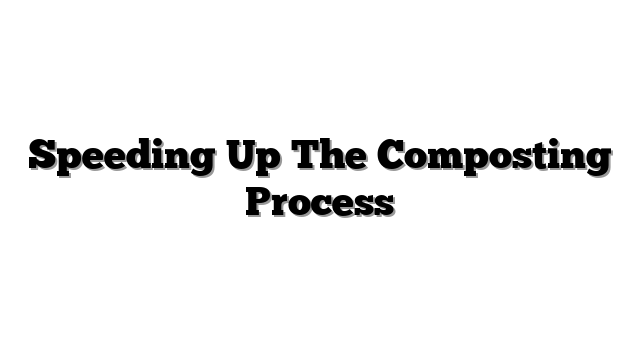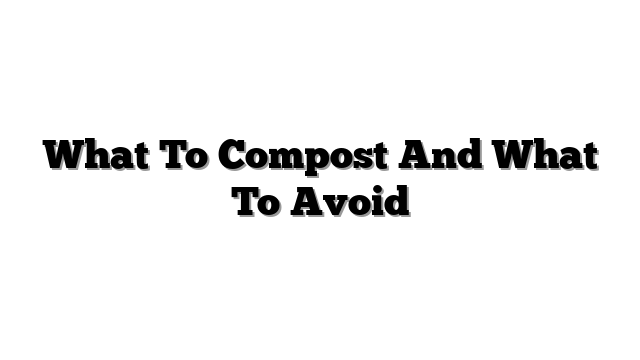Using Compost In The Garden
Are your garden plants sad? Is your soil hard like rock? Maybe water runs right through it. Many gardeners face this problem. Getting strong, healthy plants starts with soil. It is the garden’s base.
Meet compost. We call it garden “black gold.” It is natural. Compost is powerful. It helps soil a lot. It is a way to garden without waste.
This guide helps you use compost. We cover what it is. We show why it matters. Learn how to make it. See how to use it right. Make your garden healthy. Use compost for good plants. This is your guide.
The Powerhouse: What is Compost and Why Your Garden Needs It
What Exactly is Compost, Anyway?
Compost is simple stuff. It is dead plants and food. Microorganisms break it down. These are tiny living things. They eat the waste. They turn it into dark, rich soil food. This process happens slowly. It makes finished compost. Compost tea is also a thing. That is liquid compost power.
The Unbeatable Benefits of Using Compost in Your Garden
Compost does amazing things. It helps soil structure. Soil gets loose and airy. Water moves better. It makes soil like a sponge. Sandy soil holds water. Clay soil drains better.
Compost feeds your plants. It gives them food slowly. It has nitrogen. It has phosphorus. Potassium is there too. Many small nutrients are present. It is a natural plant food.
Soil life loves compost. Good bacteria live there. Fungi grow strong. Earthworms dig tunnels. Compost feeds these helpers. Healthy soil means happy soil life.
Healthy soil fights sickness. Strong plants resist bugs. Compost makes plants strong. It helps them grow well.
Compost stops waste. We keep things from trash piles. Organic stuff becomes garden food. This is a good thing. It helps our planet.
Compost can stop weeds. Put it on top of soil. It acts like a cover. Weeds find it hard to grow. This cover is called mulch.
Compost holds soil in place. It helps stop dirt washing away. This is erosion control.
Compost is a soil builder. It makes soil better. It is an organic helper.
One gardener told me this. “My plants changed completely.” “Compost made the difference.”
Feel finished compost. It feels soft. It smells like fresh earth. That is good soil health.
From Waste to Gold: Making Compost at Home
Why Make Your Own Compost?
Making compost saves money. You do not buy soil helpers. It uses your waste. You control what goes in. It is easy to do.
The Basics of Composting: Greens, Browns, Air, and Water
Composting needs four things. It needs greens. It needs browns. Air is very important. Water is needed too.
Greens have nitrogen. Grass clippings are greens. Kitchen scraps are greens. Coffee grounds are greens.
Browns have carbon. Dry leaves are browns. Shredded paper is brown. Small sticks are brown. Mix greens and browns. This mix feeds the tiny life.
Compost needs to breathe. Turn your pile sometimes. This adds air. Air helps the process.
Compost needs moisture. It should feel like a wet sponge. Not too wet. Not too dry. Add water if it is dry. Cover it if it is too wet.
Choosing Your Composting Method
You can choose how to compost. Cold composting is simple. It takes a long time. It needs little work.
Hot composting is faster. It needs more work. You turn the pile often. It gets very hot. This heat kills weed seeds. It kills bad germs too.
Use a compost bin. Many types exist. Tumblers turn easily. Simple bins hold the stuff. Just make a pile.
Worms can make compost. This is vermicomposting. Worms eat kitchen scraps. They make rich castings. Castings are worm poop. It is great for plants.
What NOT to Compost
Some things do not go in. Do not add meat. No dairy products. Oily foods cause smells. Pet waste can have germs. Sick plants spread disease. Treated wood has chemicals. Keep these out of your pile.
Troubleshooting Common Composting Problems
Sometimes problems happen. Your pile might smell bad. It could be too wet. Add more browns. It might not get warm. It needs more greens. Or it needs air. Turn it more often. It might be too dry. Add some water.
Start a small pile today. Find a spot outside. Add greens and browns. Give it air and water. Watch it change.
Knowing Your Black Gold: Different Types of Compost & Their Best Uses
Not All Compost is Created Equal
Compost is not all the same. What goes in changes it. How you make it matters. The final product differs.
Common Types of Compost
Your own compost is great. It depends on your waste.
Yard waste compost is common. Cities sometimes sell it. Check for bad stuff inside. Maybe weed killers were used.
Manure compost is strong. Cow, chicken, horse poop. It must sit a long time. Old manure will not burn plants. It has many nutrients.
Mushroom compost comes from farms. It is used mushroom beds. It might have lime. Lime changes soil pH.
Worm castings are powerful. They are very rich. Good for small plants. Great for pots.
Buy bags of compost. Read the bag label. See what is inside. Is it screened well?
Choosing the Right Compost for the Job
Match the compost to the need. Worm castings are best for pots. Use old manure for vegetables. Yard waste compost is for general beds.
Think about your plants. What do they need?
Ask questions when you buy bulk. Where did it come from? How was it made? Read those bags carefully.
Putting Compost to Work: Practical Application Techniques
When to Apply Compost
Put compost on soil. Spring is a good time. Do it before planting. Fall works well too. Add it after you harvest. You can add it anytime. Do not use frozen soil. Do not use super wet soil.
How often? Once a year is fine. Do it more if soil is bad. Plants that eat a lot need more.
How Much Compost Should You Use?
Do not use too much. Add 1-3 inches to new beds. Mix it into the soil. Add 0.5-1 inch each year. Put it on top of soil.
Pure compost is very rich. Some plants do not like that. Mixing it is usually best.
Application Methods for Different Garden Areas
New beds need compost. Dig in a few inches. Mix it with the soil. This prepares the soil.
Existing beds like top-dressing. Put an inch on top. Do this in spring. Or do it in fall. Gently mix it in. Worms will pull it down. Add some near plants. This helps plants that need food.
Lawns like compost too. Put a thin layer down. About 1/4 inch. Rake it into the grass.
Trees and bushes need it. Put it around the base. Make a layer like mulch. Keep it away from the trunk.
Pots and raised beds need it. Mix it with potting soil. About 20-30% compost is good. It helps hold water. It adds food for plants.
Compost tea is liquid food. It is compost soaked in water. Use it on leaves. Pour it on the soil. It feeds plants fast.
Measure your garden beds. Use maybe one inch of compost. That is enough for most beds. Mix it well for pots. Use about one part compost. Use three parts potting mix.
Troubleshooting & Maximizing Your Compost Results
Signs Your Soil Needs Compost
Soil looks packed down. Water sits on top. Or water drains too fast. Plants look weak. They are not green. These are signs. Your soil needs help. It needs compost.
Soil does not have much food. Plants cannot find nutrients. Compost adds food slowly.
What if My Compost Isn’t Perfect?
Maybe your compost is not finished. It still has big bits. You can still use it. Put it on top as mulch. It will finish breaking down there. Or put it in trenches. Add it to the bottom of holes.
Combining Compost with Other Soil Amendments
Compost is a soil builder. It makes soil better over time. Sometimes soil needs more help. Soil pH might be wrong. Add lime or sulfur for that. Some soils lack minerals. You can add those too. Compost works with other things. It makes soil practices better. It is not just food. It builds the soil.
Observing Your Plants: The Best Indicator
Look at your plants. Are they green and strong? Do they grow fast? That is a good sign. Your compost is working. Healthy plants tell you.
Try a simple soil test. Get a jar for texture. Test the soil pH. Do this before compost. Test again after. See how it changes.
Compost & The Future of Gardening in 2025
Compost as a Cornerstone of Sustainable Gardening
Compost helps the planet. It uses waste well. It closes the loop. Waste becomes new resource.
We use less chemicals. Less fertilizer is needed. Less bug spray too. Compost builds natural strength.
Healthy soil holds carbon. This helps fight climate change. Compost makes soil healthy.
Sustainable gardens use compost. It is a key part.
Integrating Compost with 2025 Trends
Gardening changes over time. Compost fits new ways. Native plants are popular. Healthy soil helps them grow. Native plants need less water. They help local bugs and birds.
Water saving is key. Compost holds water well. This helps in dry times. Water-wise gardens use compost.
Small spaces are common. People garden in pots. They use vertical gardens. Compost mixed in soil is needed. It gives plants what they need.
Smart garden tech is here. Sensors check soil. Compost makes soil right. Sensors work better. Watering systems work better.
Soil life is important. We learn more about it. Compost feeds the good life. It helps soil microbes grow. This makes soil truly alive.
Make compost a habit. Use it every year. Your garden will thank you. It stays strong and lively.
FAQs About Using Compost in the Garden
Q: How much compost should I use in my garden beds?
A: Use 2-3 inches for new beds. Mix it in deep. Use 0.5-1 inch for old beds. Put it on top each year. Do this in spring or fall. It helps soil health. Plants grow stronger.
Q: What materials should I avoid putting in my compost pile?
A: Do not add meat. No dairy. No oily food waste. Pet poop is bad. Sick plants spread problems. Treated wood has chemicals. Keep these out. They stop good composting.
Q: When is the best time to add compost to my garden?
A: Spring is best before planting. Fall is good after harvest. Add it when soil is not frozen. Add it when soil is not too wet. This helps plants grow later.
Q: Can I use compost in containers or raised beds?
A: Yes, you can. Mix 20-30% compost. Use it with potting mix. This is great for pots. It is great for raised beds. Soil holds water better. It drains well too. Plants get food. They stay healthy.
Q: Is compost better than chemical fertilizers?
A: Compost works differently. It builds soil structure. It makes soil healthy long term. It feeds tiny soil life. Chemical fertilizer feeds plants fast. Compost is a soil builder. It helps soil for years. It is a better soil helper.
Conclusion
Using compost helps your garden. It gives amazing benefits. Making it at home is easy. You can apply it many ways.
Healthy soil comes from compost. It is the base you need. Your garden will be strong. It will grow well. It will be sustainable.
Compost is important now. It stays important in the future. It helps gardens grow well. It helps the earth too.
Start composting today. Use compost this season. Explore more garden help here.






